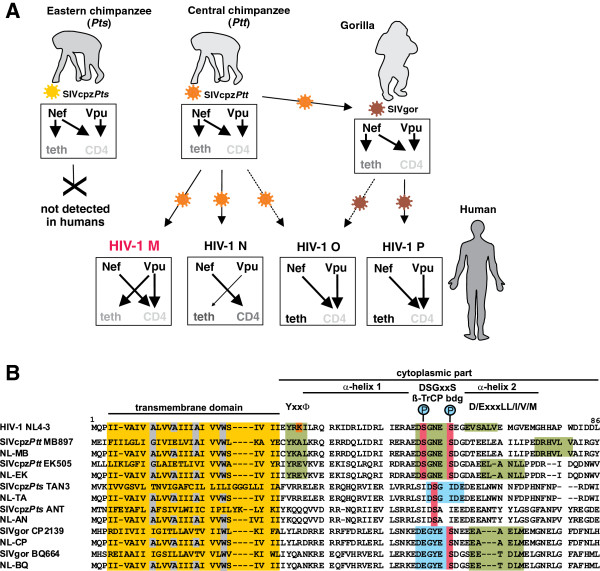Figure 1.
Zoonotic transmissions of SIVs from apes to humans and adaptive changes in Vpu and Nef functions. (A) The Nef proteins of SIVcpz and SIVgor down-modulate CD4 from the cell surface and counteract tetherin in their non-human hosts. Upon cross-species transmission of SIVcpz and SIVgor to humans, Nef-mediated tetherin antagonism was disrupted by a unique deletion in the cytoplasmic tail of the human tetherin orthologue. Subsequently, Vpu evolved to counteract tetherin during the emergence of pandemic HIV-1 M strains. In contrast, HIV-1 O and P Vpus did not gain anti-tetherin activity. Finally, Vpus of group N viruses evolved some activity against human tetherin but lost their ability to degrade CD4. The arrows indicate activity or cross-species transmissions. Grey indicates antagonism of tetherin or CD4 by one and light grey by two viral factors. (B) Alignment of SIVcpz and SIVgor Vpu amino acid sequences. The HIV-1 NL4-3 Vpu sequence is shown on top for comparison. The AxxxAxxxAxxxW residues in the TMD that are important for anti-tetherin activity of M Vpus, a putative Yxxϕ motif, two phosphorylation sites in the DSGxxS ß-TrCP interaction site, and an E/DxxxLL/I/V/M motif involved in targeting of tetherin for endosomal degradation are indicated. The consensus DSGxxS ß-TrCP interaction site is highlighted in green and sites containing mutations of the serines to acidic residues in light blue. Dashes indicate gaps introduced to optimize the alignment.

